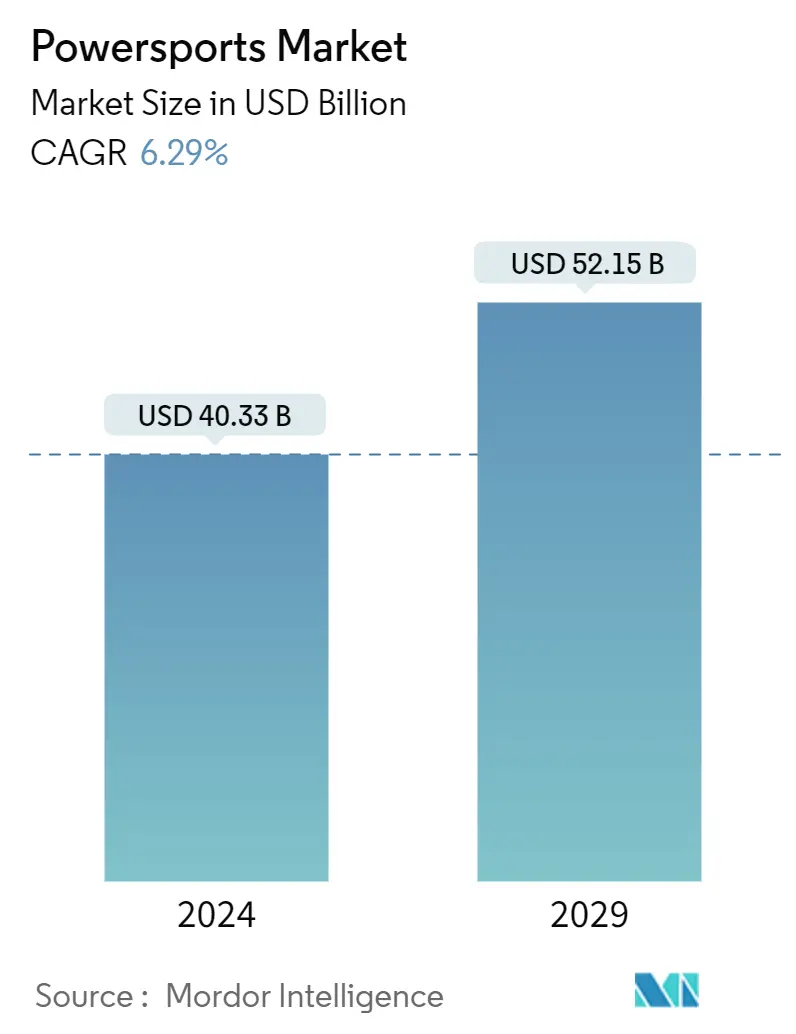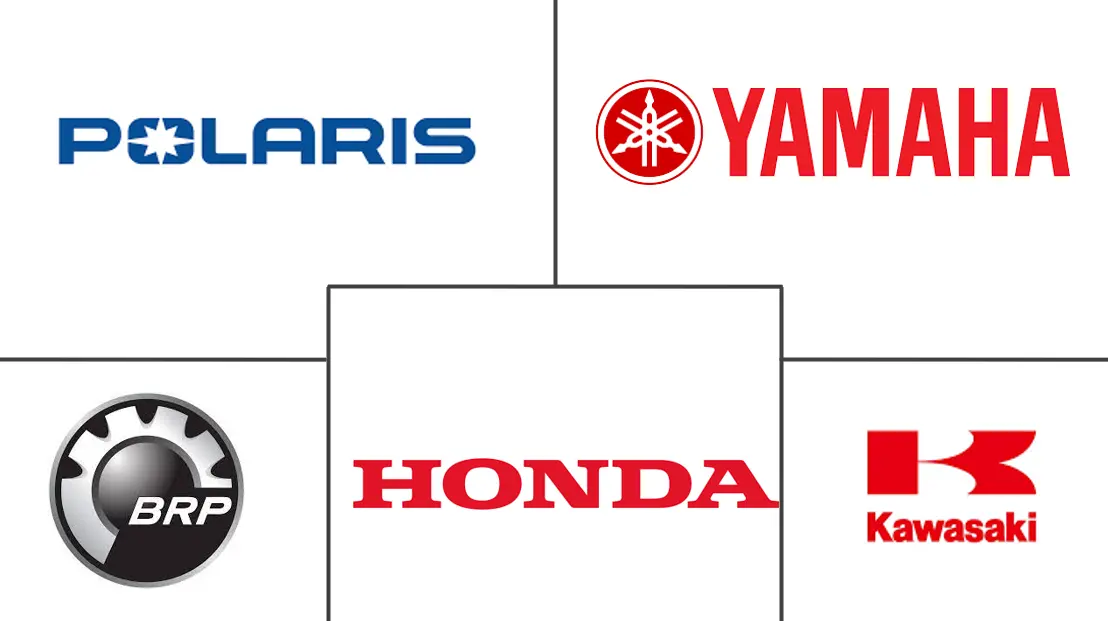Market Size of Powersports Industry

| Study Period | 2024 - 2029 |
| Market Size (2024) | USD 40.33 Billion |
| Market Size (2029) | USD 52.15 Billion |
| CAGR (2024 - 2029) | 6.29 % |
| Fastest Growing Market | Asia Pacific |
| Largest Market | North America and Europe |
| Market Concentration | Medium |
Major Players
*Disclaimer: Major Players sorted in no particular order |
Powersports Market Analysis
The Powersports Market size is estimated at USD 40.33 billion in 2024, and is expected to reach USD 52.15 billion by 2029, growing at a CAGR of 6.29% during the forecast period (2024-2029).
The powersports market exhibits a consolidated landscape, dominated by a few major global players such as Polaris Inc., Yamaha Motor Co. Ltd, Harley-Davidson Inc., BRP Inc., Honda Motor Co. Ltd, Kawasaki Heavy Industries, Suzuki Motor Corporation, and others. These companies have established a stronghold in the market through extensive product portfolios, technological advancements, and strategic collaborations.
The powersports industry holds significant importance in the global economy, contributing to job creation, tourism, and the overall leisure and sports sector. In recent years, the market has experienced steady growth, driven by factors such as increasing disposable incomes, urbanization, and a growing interest in adventure sports and recreational activities. In 2023, global disposable income was USD 69.64 trillion, which is 0.89 % greater than the previous year (2022). This data shows the incremental increase in income, which surely impacts spending on such recreational and interesting vehicles.
Several key factors have contributed to the growth of the Powersports market in recent times. One of the primary drivers is the rising demand for adventure and travel, as people seek to escape their daily routines and engage in thrilling experiences. In 2022, the total contribution of travel and tourism to the global gross domestic product (GDP) was 23 percent lower than in 2019. In 2022, the United States and China were by far the leading travel markets based on the total contribution of travel and tourism to GDP. That year, Germany, the United Kingdom, and Japan followed in the ranking. Additionally, advancements in technology have led to the development of more efficient, eco-friendly, and technologically advanced vehicles, making them more appealing to consumers. Furthermore, the growing trend of personalization and customization in the automotive industry has extended to Powersports vehicles, allowing customers to tailor their machines to their specific needs and preferences.
Despite the growth trends, the powersports market faces several challenges and obstacles. One of the significant challenges is the increasing focus on environmental sustainability, leading to stricter emissions standards and regulatory requirements. Manufacturers must invest in research and development to create eco-friendly vehicles that adhere to these guidelines while maintaining performance and appeal. Another challenge is the fluctuating global economy, which can impact consumer spending and demand for powersports vehicles.
However, these challenges also present opportunities for growth and innovation. For instance, the push for sustainability has led to the emergence of electric and hybrid powersports vehicles, opening new segments in the market. Additionally, the increasing global demand for adventure tourism and outdoor recreational activities provides a vast potential customer base for powersports manufacturers. Furthermore, the increasing focus on sustainability is likely to drive the development of electric and hybrid vehicles, expanding the market and catering to the growing environmental consciousness of consumers.
Powersports Industry Segmentation
Powersports refer to a diverse range of motorized machines designed for recreational and sports purposes, including motorcycles, all-terrain vehicles (ATVs), utility task vehicles (UTVs), snowmobiles, and personal watercraft. These vehicles cater to enthusiasts seeking adventure, leisure, and outdoor activities while manufacturers continuously innovate to meet evolving consumer demands and environmental concerns.
The powersports market is segmented into vehicle type, propulsion type, application, and geography. Based on the vehicle type, the market is segmented into personal watercraft, all-terrain vehicles, heavyweight motorcycles, side-by-side vehicles, and snowmobiles. Based on the propulsion type, the market is segmented into diesel, gasoline, and electric. Based on the application, the market is segmented into on-road and off-road. Based on geography, the market is segmented into North America, Europe, Asia-Pacific, and the Rest of the World.
For each segment, the market size and forecast were based on the value of USD.
| Vehicle type | |
| Personal watercrafts | |
| All-terrain vehicles | |
| Heavy weight motorcycles | |
| Side by side vehicles | |
| Snow mobiles |
| Propulsion | |
| Diesel | |
| Gasoline | |
| Electric |
| Application | |
| On-Road | |
| Off-Road |
| Geography | ||||||||
| ||||||||
| ||||||||
| ||||||||
| ||||||||
|
Powersports Market Size Summary
The Powersports market is characterized by a consolidated landscape, with major global players such as Polaris Inc., Yamaha Motor Co. Ltd, Harley-Davidson Inc., BRP Inc., Honda Motor Co. Ltd, Kawasaki Heavy Industries, and Suzuki Motor Corporation leading the industry. These companies have secured their positions through extensive product offerings, technological innovations, and strategic partnerships. The market is significant to the global economy, contributing to job creation and the leisure sector, and has seen steady growth driven by increasing disposable incomes, urbanization, and a rising interest in adventure sports and recreational activities. The shift in consumer preferences towards outdoor and adventure activities, coupled with advancements in vehicle technology, has further fueled demand for Powersports vehicles.
Despite the growth, the Powersports market faces challenges such as environmental sustainability and fluctuating economic conditions, which can impact consumer spending. However, these challenges also present opportunities for innovation, such as the development of electric and hybrid vehicles. The Asia-Pacific region is experiencing notable growth due to rising disposable incomes, a growing middle class, and increased leisure activities, particularly among the younger generation. Government policies promoting eco-friendly transportation are also influencing market dynamics. The future of the Powersports market looks promising, with technological advancements, product innovations, and a focus on sustainability expected to drive significant growth in the coming years.
Powersports Market Size - Table of Contents
-
1. MARKET DYNAMICS
-
1.1 Market Overview
-
1.2 Market Drivers
-
1.2.1 Increasing disposable income and consumer preferences for adventure sports propel the market growth
-
-
1.3 Market Restraints
-
1.3.1 High initial investment and maintenance costs obstruct the market growth
-
-
1.4 Value Chain / Supply Chain Analysis
-
1.5 Porters 5 Force Analysis
-
1.5.1 Threat of New Entrants
-
1.5.2 Bargaining Power of Buyers/Consumers
-
1.5.3 Bargaining Power of Suppliers
-
1.5.4 Threat of Substitute Products
-
1.5.5 Intensity of Competitive Rivalry
-
-
1.6 PESTLE Analysis
-
-
2. MARKET SEGMENTATION
-
2.1 Vehicle type
-
2.1.1 Personal watercrafts
-
2.1.2 All-terrain vehicles
-
2.1.3 Heavy weight motorcycles
-
2.1.4 Side by side vehicles
-
2.1.5 Snow mobiles
-
-
2.2 Propulsion
-
2.2.1 Diesel
-
2.2.2 Gasoline
-
2.2.3 Electric
-
-
2.3 Application
-
2.3.1 On-Road
-
2.3.2 Off-Road
-
-
2.4 Geography
-
2.4.1 North America
-
2.4.1.1 US
-
2.4.1.2 Canada
-
2.4.1.3 Mexico
-
2.4.1.4 Rest of North America
-
-
2.4.2 Europe
-
2.4.2.1 Germany
-
2.4.2.2 UK
-
2.4.2.3 France
-
2.4.2.4 Russia
-
2.4.2.5 Spain
-
2.4.2.6 Rest of Europe
-
-
2.4.3 Asia Pacific
-
2.4.3.1 India
-
2.4.3.2 China
-
2.4.3.3 Japan
-
2.4.3.4 Rest of Asia Pacific
-
-
2.4.4 South America
-
2.4.4.1 Brazil
-
2.4.4.2 Argentina
-
-
2.4.5 Middle East
-
2.4.5.1 UAE
-
2.4.5.2 Saudi Arabia
-
2.4.5.3 Rest of Middle East
-
-
-
Powersports Market Size FAQs
How big is the Powersports Market?
The Powersports Market size is expected to reach USD 40.33 billion in 2024 and grow at a CAGR of 6.29% to reach USD 52.15 billion by 2029.
What is the current Powersports Market size?
In 2024, the Powersports Market size is expected to reach USD 40.33 billion.

